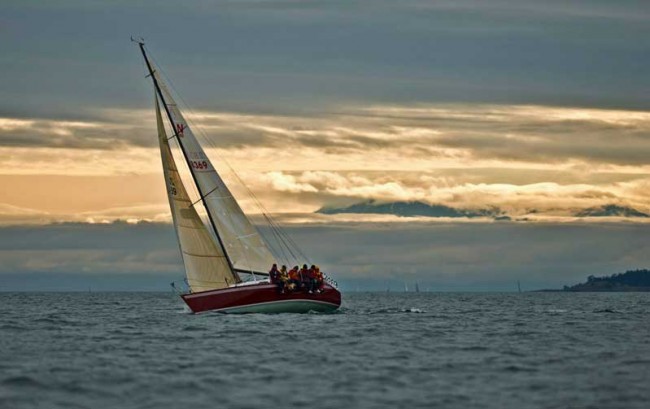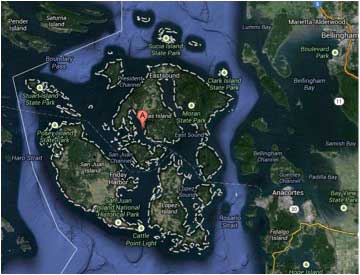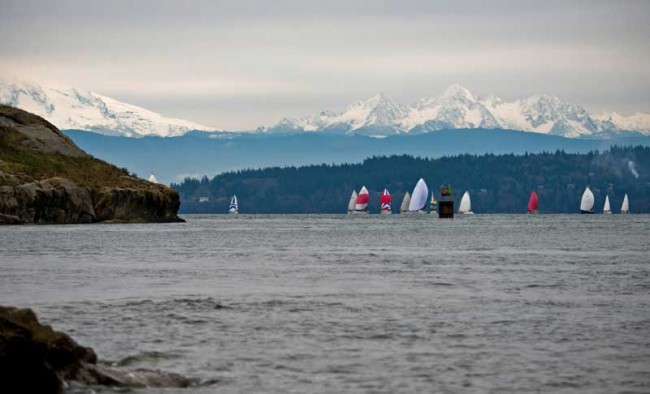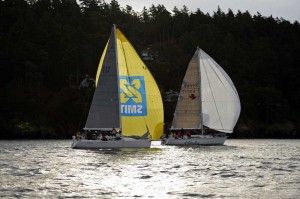Dan Newland Reports on PEGASUS’s Race in the 2013 Round The County. Photo’s by Sean Trew.

PEGASUS at Round The County, 2013. Photo by Sean Trew
This years’ RTC was an interesting contrast between what should have been and what was. It should have had decent wind Saturday with light winds Sunday but reality has its own agenda. The County Race (RTC), it is an annual race that races around San Juan County which comprises all the major San Juan Islands like Orcas, San Juan and Lopez Islands plus the nearly countless smaller islands, rocks and reefs of this under water mountain range between the US mainland and Canada. On even years, it goes around the islands clockwise and on odd years like this year, goes counterclockwise. The total distance is about 65 miles overall with the first leg Saturday to Roche Harbor at 34.3 miles and the halfway /shortened course mark at 17 nautical miles from the start. The second day starts off Mosquito pass near Roche Harbor, is 16.4 miles to the halfway/shortened course mark with 31.4 miles for the full distance. The race is so popular that the fleet is limited in size with this year at the typical maximum of 89 boats.

The San Juan Archipelago
Our day on board Pegasus XIV began from Anacortes Saturday morning having delivered the boat there the day before. We left the dock at 7:15 and with the current behind us at 2 knots, we were able to cover the 8.5 miles pretty quickly for what should have been our start at around 8:50 at Lydia Shoals, a bell buoy off the SE corner of Orcas Island. The wind was from the east at 9-12 knots and the weather was hazy but not overcast so it promised to be a great day of sailing. By the time we reached the starting line though, it had already shown signs of lightening up with lulls down to 6 knots and dropping while also swinging north. The wind was atypical in that it was 180 degrees from the normal southerly direction which meant an upwind start for this years’ counterclockwise direction.
By the time the first start was to happen for the slower boats in PHRF divisions 2 and 3, the winds were so light that few boats could maintain station going against the current from the south and the light northerly and that included us in Divisions 0 and 1. The winds finally picked up a bit and the first divisions sequence was started at about 8:50 but so many boats were over the line early, they were called back for a general recall. The start #1 redo was delayed a bit for more wind which finally did materialize so the next sequence did get off without a hitch. The next two starts went off without general recalls a bit after 10:00 so we had a race! We were fairly conservative as were many others since being early would have been deadly against that current had anyone had to return for a restart. Some of the local boats went in shore on a long starboard picking up a lift on the port tack and crossed ahead of those of us that went out for more current but it was a long race so a few seconds would mean little in the overall scheme of things.

Photo by Sean Trew
The fleet split with many boats heading east out into the channel more looking for more current while many of us went further west trying to shorten the distance as we continued to turn left with the islands on our port side. The first hour was pretty good with the current carrying everyone toward the half way point at Patos Island. But it was about then that the winds started to lighten up and clock aft. We passed the twice overall winner, the 106 year old schooner “Martha” at about this time seeing her loose steerage a time or two as she pointed in some random direction. We hoisted the .5 oz spinnaker which was very effective at least initially but as the day wore on, the wind lightened more and became variable so that even the light kite couldn’t fly so we alternated between the ½ oz and light genoa. We also noted that while we were holding pretty even with the boats farther offshore earlier, as the wind lightened and the current started to swing, the boats farther east started creeping away from us. In the end try as we might, we couldn’t get there and we saw them slowly pull ahead from those of us farther west that were initially only slightly farther inshore. I suppose we all like to think that something else other than us are responsible for a poor placing but since I had made the decisions and Pegasus was a boat I designed and built and even made some of the sails for, there were not a whole lot of others to blame for a poor performance. Except for when we did a check and noticed that we had a stalk of kelp, bulb and all, stuck on the keel of Pegasus. How long it had been there wasn’t known but we were normally faster than this even though Peggy wasn’t really a light wind boat much preferring a good breeze either upwind or down but for now the die was cast and had to live with the hand we were dealt.

Photo by Sean Trew
By the time we reached Matia Island, the day was waning and the fastest boats from the IRC and class 0 divisions had blown past us like a freight train through warm butter, however the current was now against us and we were slipping backwards over the bottom. It was looking like few boats would even make the shortened course finish line at the halfway point of Patos Island by the shut off at 1600 hours. As we started drifting backwards in winds from 0 gusting to 2.5 knots, we saw the ability to finish slipping away so we “pulled the plug” and retired heading to Roche Harbor for an evening of licking wounds and telling stories that were “absolutely true”. As it turned out, only one boat in our division made it to the halfway point and only half of even the super fast IRC boats made it there to get a score. But it should be noted that most of the IRC boats that did make it to the halfway point were also able to make it all the way around and finish by 1800 hours. Making the corner at the change of current gave them a boost, one that no one else had. In our division 1, there was one boat that was able to finish, an Express 37, Ptolemy that sailed a Hell of a race to get where they were but there were no other half way finishers in our division nor any in of divisions 2 or 3.
Sunday started with more wind from the North at 8-12 knots and the current against the fleet flooding north at 2 knots. This was a GREAT thing though since with the more typical direction from the south, the normal short tacking was replaced with gybing, (we stopped counting after 200 tacks in 2009 under similar current conditions but southerly winds). Starting as we did behind the slower boats meant we had to sail through the fleet which we did fairly quickly and the IRC fleet likewise blowing through us just as quickly. After an hour, the fleet started venturing away from the shore while having to balance current offshore to the right vs. turning left for a shorter course and a “gate” off of Iceberg Point that required coming within ½ mile of land to be recorded for our halfway check in. We called in for the half way point check in and were listed as crossing the line at 1139 hours placing us in first in our division, and ahead of most of the faster division 0 meaning we were near the top overall, we were kicking ass! We got through the light area below the southern part of San Juan Island then hardened up to the fresh breeze and now adverse current from the north. We did a few tacks in to the west but generally found it more favorable to head east. This worked well as we watched our competition dwindle in the distance until they were small vertical lines with no part of the hull visible. We were liking these conditions and staying up with a lot of really big boats upwind. There were many places to gain or lose given these conditions but on the whole, we were doing well, sometimes gaining and at other times loosing but staying at the top for the most part. For the next few hours we continued to sail a good race and were doing great in these 12 knot winds that were near the top of the maximum velocity for our new genoa. We heard the IRC boats start checking in for their finish at around 1400 hours with us not too far behind.
Oh that this was to remain the case!
As we started nearing the finish, a new wind started developing, one that was 180 degrees opposed to the fresh northerly we had enjoyed. This meant a transition we had to go through and not a breath of wind between. And of course the current was against us at the requite 2 knots with anchoring out of the question at the 200+ feet of depth. This brought the fleet that we had been so far in front of up close. A few boats split to the west as we got trapped 3 miles from the finish near the lee of Orcas Island. The kites came out and Zulu, a Canadian boat that we had been so close to in our division, got a puff in the last of the dying wind to take off with a full kite as we sagged and died a few yards behind. We struggled for the next 20 minutes passing a few boats in our cluster but ended up crossing the line virtually overlapped with two boats from our division that we owed handicap time to, Vitesse and Ptolomy. We spoke with them later and they said they saw our predicament and went east in the last of the old breeze before heading toward the finish with spinnakers ghosting along top gain a lot in the last mile or so2.

Photo by Sean Trew
We finished 4th in our division and 16th overall which wasn’t bad but given how far ahead we were only a half hour before, it was frustrating. The IRC boats and really low rating PHRF boats were the overall winners and able to sail through that without having to deal with the light wind that came up late in the game. We were one of only 6 boats to finish in our division Sunday and there were no finishers for the long course Sunday in divisions 2 and 3 so the halfway scores were used for them. Almost predictably, the beautiful schooner Martha was the top overall scorer having beaten many of the newer IRC and Class 0 boats to the halfway point boat for boat on the windy downwind and reaching leg! What a kick! But it must be said that in addition to being beautifully and lovingly maintained, Robert and Holly D’Arcy sail her extremely well. Her wins are from being sailed well, going the right way and being fast. And of course the long waterline doesn’t hurt one bit in a breeze while having everyone owe her time!
Given our inexperience in racing around the San Juan Islands, we did very well but it was a bitter pill to have an insurmountable lead surmounted. But that is the nature of racing in the San Juan Islands in November, a crazy time of year to race in a crazy race around what can only be described as one of the planet’s most beautiful spots. The San Juan Islands are indeed a jewel and cold or not, gives you the opportunity to see so much nature with harbor porpoise, seals, sea lions, bald eagles, mountains and trees displayed before you in such abundance it is stunning. There is nowhere like this on Earth and in November, it is our playground with all of the cruisers having quite sensibly left us alone. It is absolutely a race that should be on everyone’s bucket list!